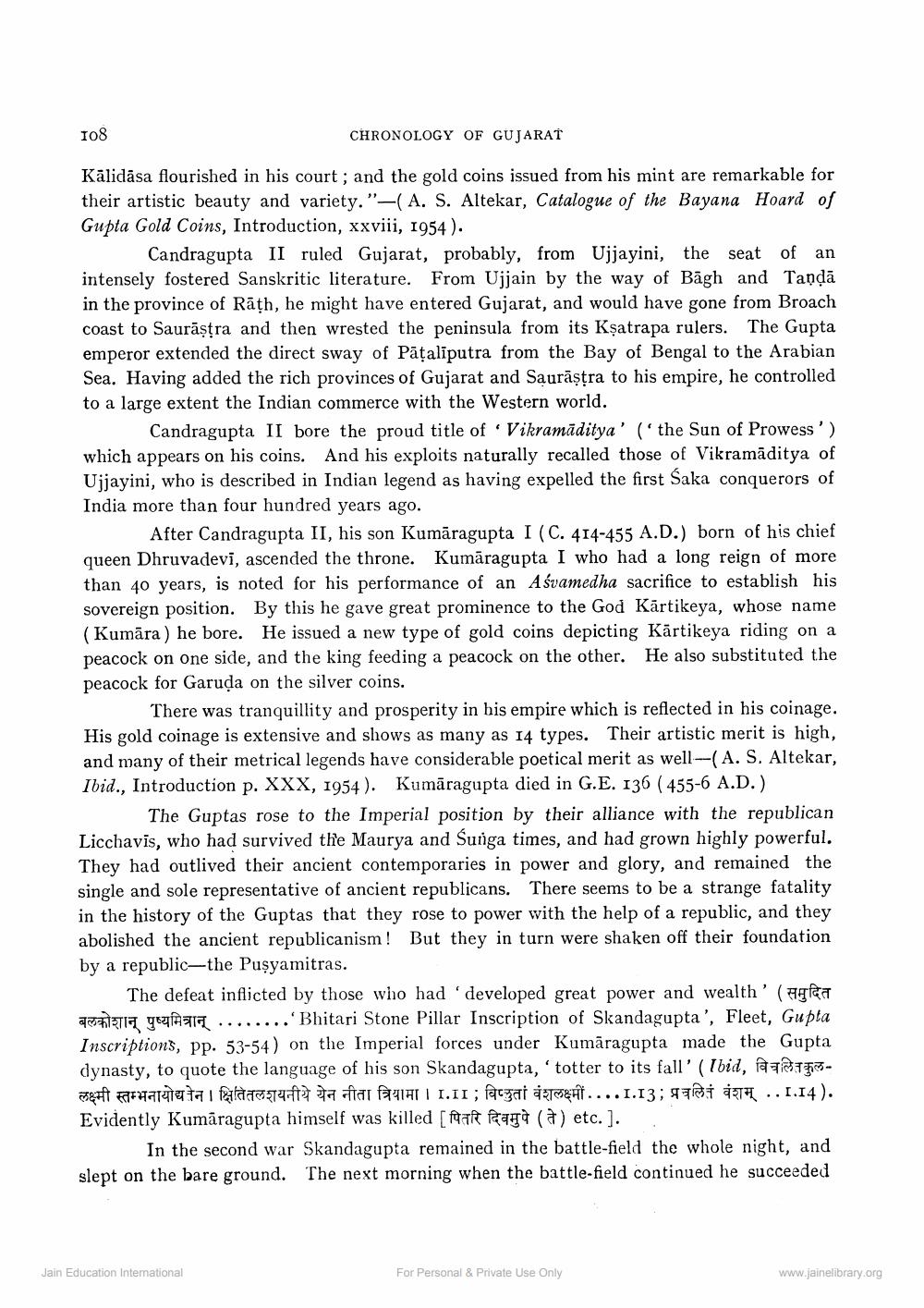________________
108
CHRONOLOGY OF GUJARAT
Kālidāsa flourished in his court; and the gold coins issued from his mint are remarkable for their artistic beauty and variety.”—A. S. Altekar, Catalogue of the Bayana Hoard of Gupta Gold Coins, Introduction, xxviii, 1954).
Candragupta II ruled Gujarat, probably, from Ujjayini, the seat of an intensely fostered Sanskritic literature. From Ujjain by the way of Bāgh and Tandā in the province of Rāth, he might have entered Gujarat, and would have gone from Broach coast to Saurāṣtra and then wrested the peninsula from its Kşatrapa rulers. The Gupta emperor extended the direct sway of Pāțalīputra from the Bay of Bengal to the Arabian Sea. Having added the rich provinces of Gujarat and Saurāșțra to his empire, he controlled to a large extent the Indian commerce with the Western world.
Candragupta II bore the proud title of Vikramāditya' ('the Sun of Prowess') which appears on his coins. And his exploits naturally recalled those of Vikramaditya of Ujjayini, who is described in Indian legend as having expelled the first Saka conquerors of India more than four hundred years ago.
After Candragupta II, his son Kumāragupta I (C. 414-455 A.D.) born of his chief queen Dhruvadevi, ascended the throne. Kumāragupta I who had a long reign of more than 40 years, is noted for his performance of an Aśvamedha sacrifice to establish his sovereign position. By this he gave great prominence to the God Kārtikeya, whose name (Kumāra) he bore. He issued a new type of gold coins depicting Kārtikeya riding on a peacock on one side, and the king feeding a peacock on the other. He also substituted the peacock for Garuda on the silver coins.
There was tranquillity and prosperity in his empire which is reflected in his coinage. His gold coinage is extensive and shows as many as 14 types. Their artistic merit is high, and many of their metrical legends have considerable poetical merit as well ---(A. S. Altekar, Ibid., Introduction p. XXX, 1954). Kumāragupta died in G.E. 136 ( 455-6 A.D.)
The Guptas rose to the Imperial position by their alliance with the republican Licchavis, who had survived the Maurya and Sunga times, and had grown highly powerful. They had outlived their ancient contemporaries in power and glory, and remained the single and sole representative of ancient republicans. There seems to be a strange fatality in the history of the Guptas that they rose to power with the help of a republic, and they abolished the ancient republicanism! But they in turn were shaken off their foundation by a republic—the Pusyamitras.
The defeat inflicted by those who had 'developed great power and wealth' (Agfaa
Tia ........ Bhitari Stone Pillar Inscription of Skandagupta', Fleet, Gupta Inscriptions, pp. 53-54) on the Imperial forces under Kumāragupta made the Gupta dynasty, to quote the language of his son Skandagupta, 'totter to its fall' (Ibid, at - gift formaliteta i d e tta oftar MAI LII; facgai teht....1.13; @ Th ..1.14). Evidently Kumāragupta himself was killed [foart Rate (a) etc. ).
In the second war Skandagupta remained in the battle-field the whole night, and slept on the bare ground. The next morning when the battle-field continued he succeeded
Jain Education Intemational
For Personal & Private Use Only
www.jainelibrary.org




